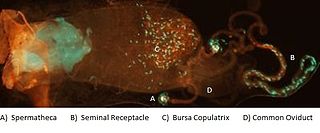
The bowl and doily spider is a species of sheet weaver found in North and Central America. It is a small spider, about 4 mm (0.16 in) long, that weaves a fairly complex and unique sheet web system consisting of an inverted dome shaped web, or "bowl," suspended above a horizontal sheet web, or "doily", hence its common name. The spider hangs from the underside of the "bowl", and bites through the web small flies, gnats and other small insects that fall down into the non-sticky webbing. The webs are commonly seen in weedy fields and in shrubs, and may often contain both a male and a female spider in late summer—like many linyphiids, Frontinella males and females may cohabitate for some time. Males exhibit competition for female mates both by fighting and sperm competition. Uniquely, these spiders exhibit behavioral thermoregulation and have lengthened circadian rhythms.

Sperm competition is the competitive process between spermatozoa of two or more different males to fertilize the same egg during sexual reproduction. Competition can occur when females have multiple potential mating partners. Greater choice and variety of mates increases a female's chance to produce more viable offspring. However, multiple mates for a female means each individual male has decreased chances of producing offspring. Sperm competition is an evolutionary pressure on males, and has led to the development of adaptations to increase male's chance of reproductive success. Sperm competition results in a sexual conflict between males and females. Males have evolved several defensive tactics including: mate-guarding, mating plugs, and releasing toxic seminal substances to reduce female re-mating tendencies to cope with sperm competition. Offensive tactics of sperm competition involve direct interference by one male on the reproductive success of another male, for instance by physically removing another male's sperm prior to mating with a female. For an example, see Gryllus bimaculatus.

Anisogamy is a form of sexual reproduction that involves the union or fusion of two gametes that differ in size and/or form. The smaller gamete is male, a sperm cell, whereas the larger gamete is female, typically an egg cell. Anisogamy is predominant among multicellular organisms. In both plants and animals gamete size difference is the fundamental difference between females and males.
External fertilization is a mode of reproduction in which a male organism's sperm fertilizes a female organism's egg outside of the female's body. It is contrasted with internal fertilization, in which sperm are introduced via insemination and then combine with an egg inside the body of a female organism. External fertilization typically occurs in water or a moist area to facilitate the movement of sperm to the egg. The release of eggs and sperm into the water is known as spawning. In motile species, spawning females often travel to a suitable location to release their eggs.
Monogamous pairing in animals refers to the natural history of mating systems in which species pair bond to raise offspring. This is associated, usually implicitly, with sexual monogamy.

Gryllus bimaculatus is a species of cricket in the subfamily Gryllinae. Most commonly known as the two-spotted cricket, it has also been called the "African" or "Mediterranean field cricket", although its recorded distribution also includes much of Asia, including China and Indochina through to Borneo. It can be discriminated from other Gryllus species by the two dot-like marks on the base of its wings.

Sexual conflict or sexual antagonism occurs when the two sexes have conflicting optimal fitness strategies concerning reproduction, particularly over the mode and frequency of mating, potentially leading to an evolutionary arms race between males and females. In one example, males may benefit from multiple matings, while multiple matings may harm or endanger females, due to the anatomical differences of that species. Sexual conflict underlies the evolutionary distinction between male and female.

Sexual cannibalism is when an animal, usually the female, cannibalizes its mate prior to, during, or after copulation. It is a trait observed in many arachnid orders and several insect and crustacean clades. Several hypotheses to explain this seemingly paradoxical behavior have been proposed. The adaptive foraging hypothesis, aggressive spillover hypothesis and mistaken identity hypothesis are among the proposed hypotheses to explain how sexual cannibalism evolved. This behavior is believed to have evolved as a manifestation of sexual conflict, occurring when the reproductive interests of males and females differ. In many species that exhibit sexual cannibalism, the female consumes the male upon detection. Females of cannibalistic species are generally hostile and unwilling to mate; thus many males of these species have developed adaptive behaviors to counteract female aggression.

The sexy son hypothesis in evolutionary biology and sexual selection, proposed by Patrick J. Weatherhead and Raleigh J. Robertson of Queen's University in Kingston, Ontario in 1979, states that a female's ideal mate choice among potential mates is one whose genes will produce males with the best chance of reproductive success. This implies that other benefits the father can offer the mother or offspring are less relevant than they may appear, including his capacity as a parental caregiver, territory and any nuptial gifts. Fisher's principle means that the sex ratio is always near 1:1 between males and females, yet what matters most are her "sexy sons'" future breeding successes, more likely if they have a promiscuous father, in creating large numbers of offspring carrying copies of her genes. This sexual selection hypothesis has been researched in species such as the European pied flycatcher.

Traumatic insemination, also known as hypodermic insemination, is the mating practice in some species of invertebrates in which the male pierces the female's abdomen with his aedeagus and injects his sperm through the wound into her abdominal cavity (hemocoel). The sperm diffuses through the female's hemolymph, reaching the ovaries and resulting in fertilization.

A courtship display is a set of display behaviors in which an animal, usually a male, attempts to attract a mate; the mate exercises choice, so sexual selection acts on the display. These behaviors often include ritualized movement ("dances"), vocalizations, mechanical sound production, or displays of beauty, strength, or agonistic ability.

The red flour beetle is a species of beetle in the family Tenebrionidae, the darkling beetles. It is a worldwide pest of stored products, particularly food grains, and a model organism for ethological and food safety research.

Utetheisa ornatrix, also called the ornate bella moth, ornate moth, bella moth or rattlebox moth is a moth of the subfamily Arctiinae. It is aposematically colored ranging from pink, red, orange and yellow to white coloration with black markings arranged in varying patterns on its wings. It has a wingspan of 33–46 mm. Moths reside in temperate midwestern and eastern North America as well as throughout Mexico and other parts of Central America. Unlike most moths, the bella moth is diurnal. Formerly, the bella moth or beautiful utetheisa of temperate eastern North America was separated as Utetheisa bella. Now it is united with the bella moth in Utetheisa ornatrix.

Female sperm storage is a biological process and often a type of sexual selection in which sperm cells transferred to a female during mating are temporarily retained within a specific part of the reproductive tract before the oocyte, or egg, is fertilized. This process takes place in some species of animals, but not in humans. The site of storage is variable among different animal taxa and ranges from structures that appear to function solely for sperm retention, such as insect spermatheca and bird sperm storage tubules, to more general regions of the reproductive tract enriched with receptors to which sperm associate before fertilization, such as the caudal portion of the cow oviduct containing sperm-associating annexins. Female sperm storage is an integral stage in the reproductive process for many animals with internal fertilization. It has several documented biological functions including:
A nuptial gift is a nutritional gift given by one partner in some animals' sexual reproduction practices.

Sexual selection in birds concerns how birds have evolved a variety of mating behaviors, with the peacock tail being perhaps the most famous example of sexual selection and the Fisherian runaway. Commonly occurring sexual dimorphisms such as size and color differences are energetically costly attributes that signal competitive breeding situations. Many types of avian sexual selection have been identified; intersexual selection, also known as female choice; and intrasexual competition, where individuals of the more abundant sex compete with each other for the privilege to mate. Sexually selected traits often evolve to become more pronounced in competitive breeding situations until the trait begins to limit the individual's fitness. Conflicts between an individual fitness and signaling adaptations ensure that sexually selected ornaments such as plumage coloration and courtship behavior are "honest" traits. Signals must be costly to ensure that only good-quality individuals can present these exaggerated sexual ornaments and behaviors.

Sexual selection in mammals is a process the study of which started with Charles Darwin's observations concerning sexual selection, including sexual selection in humans, and in other mammals, consisting of male–male competition and mate choice that mold the development of future phenotypes in a population for a given species.

Sexual selection in scaled reptiles studies how sexual selection manifests in snakes and lizards, which constitute the order Squamata of reptiles. Each of the over three thousand snakes use different tactics in acquiring mates. Ritual combat between males for the females they want to mate with includes topping, a behavior exhibited by most viperids in which one male will twist around the vertically elevated fore body of its opponent and forcing it downward. It is common for neck biting to occur while the snakes are entwined.

Sexual selection in amphibians involves sexual selection processes in amphibians, including frogs, salamanders and newts. Prolonged breeders, the majority of frog species, have breeding seasons at regular intervals where male-male competition occurs with males arriving at the waters edge first in large number and producing a wide range of vocalizations, with variations in depth of calls the speed of calls and other complex behaviours to attract mates. The fittest males will have the deepest croaks and the best territories, with females making their mate choices at least partly based on the males depth of croaking. This has led to sexual dimorphism, with females being larger than males in 90% of species, males in 10% and males fighting for groups of females.

In behavioral ecology, polyandry is a class of mating system where one female mates with several males in a breeding season. Polyandry is often compared to the polygyny system based on the cost and benefits incurred by members of each sex. Polygyny is where one male mates with several females in a breeding season . A common example of polyandrous mating can be found in the field cricket of the invertebrate order Orthoptera. Polyandrous behavior is also prominent in many other insect species, including the red flour beetle and the species of spider Stegodyphus lineatus. Polyandry also occurs in some primates such as marmosets, mammal groups, the marsupial genus' Antechinus and bandicoots, around 1% of all bird species, such as jacanas and dunnocks, insects such as honeybees, and fish such as pipefish.

















